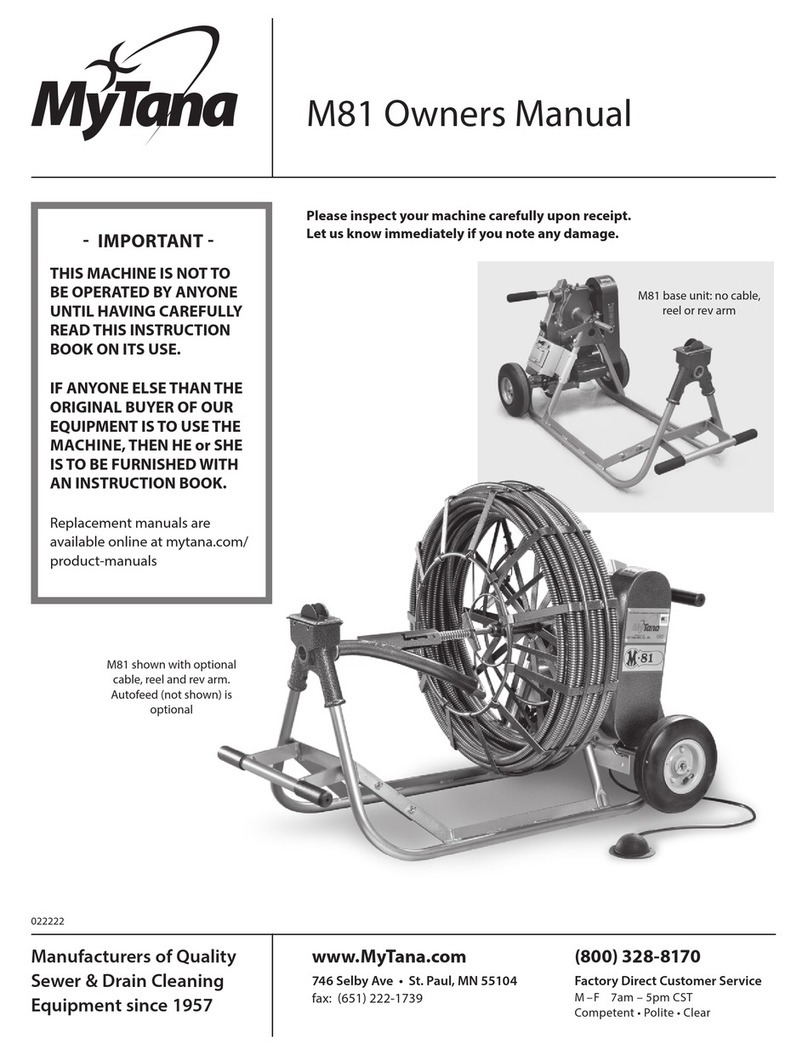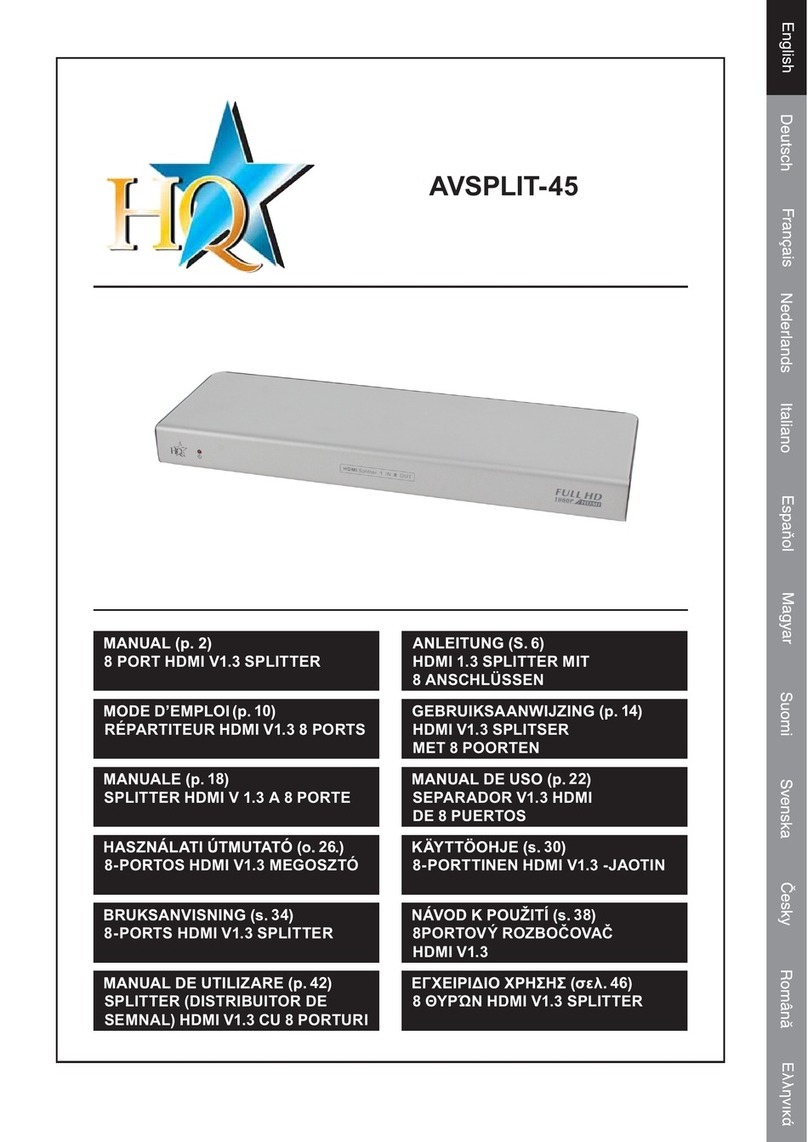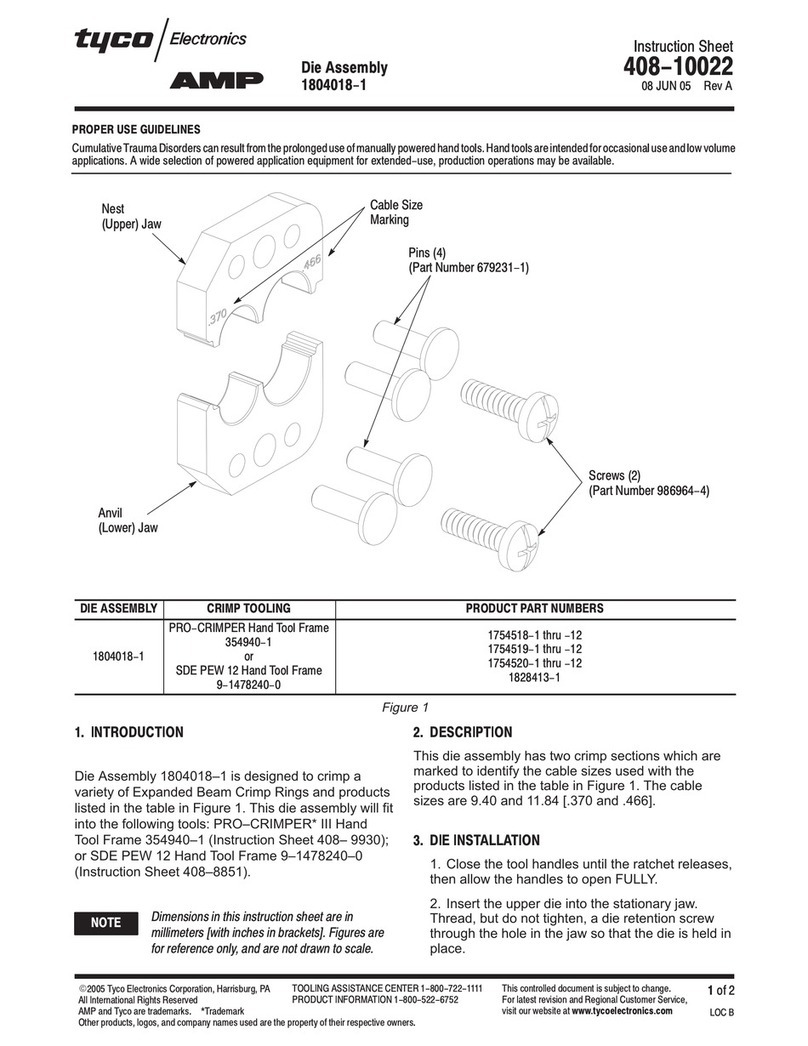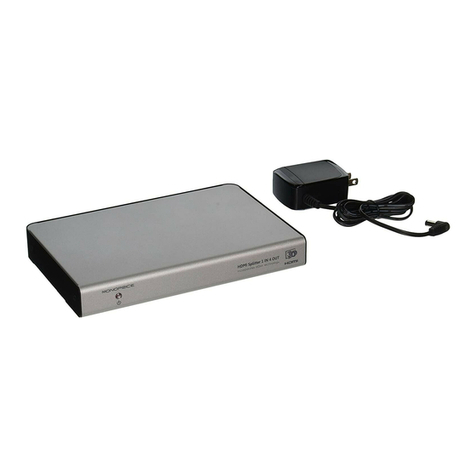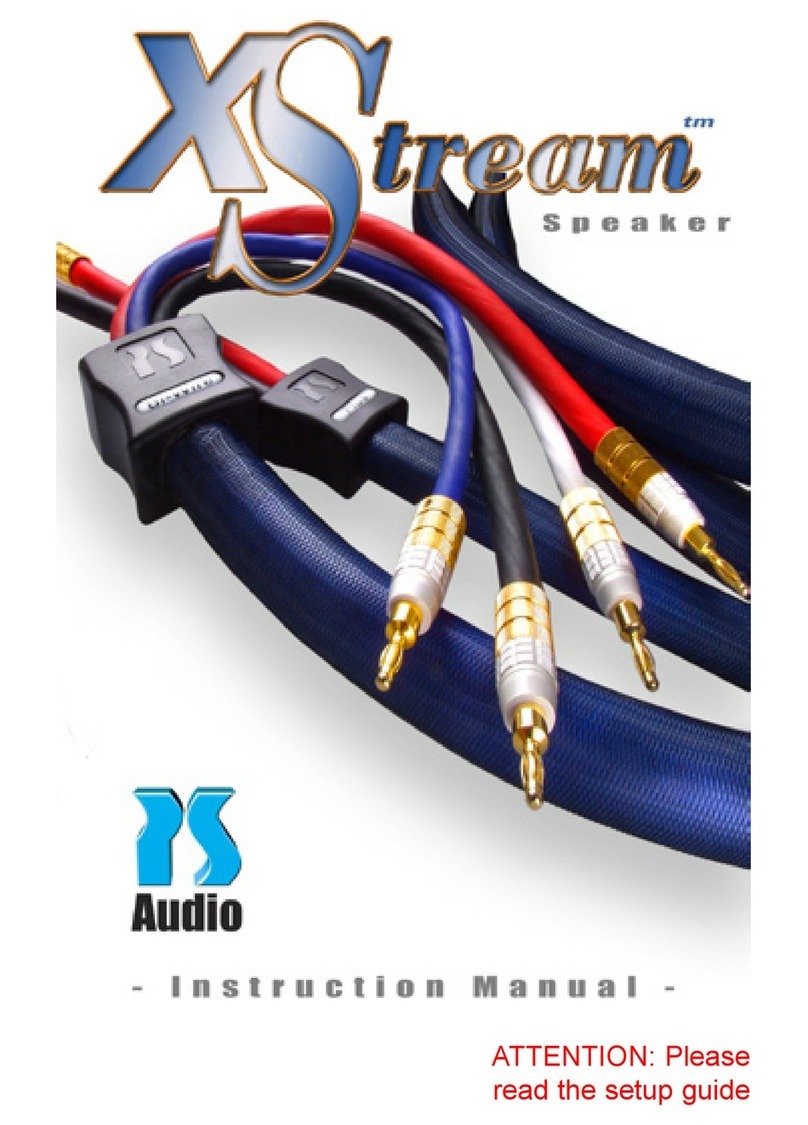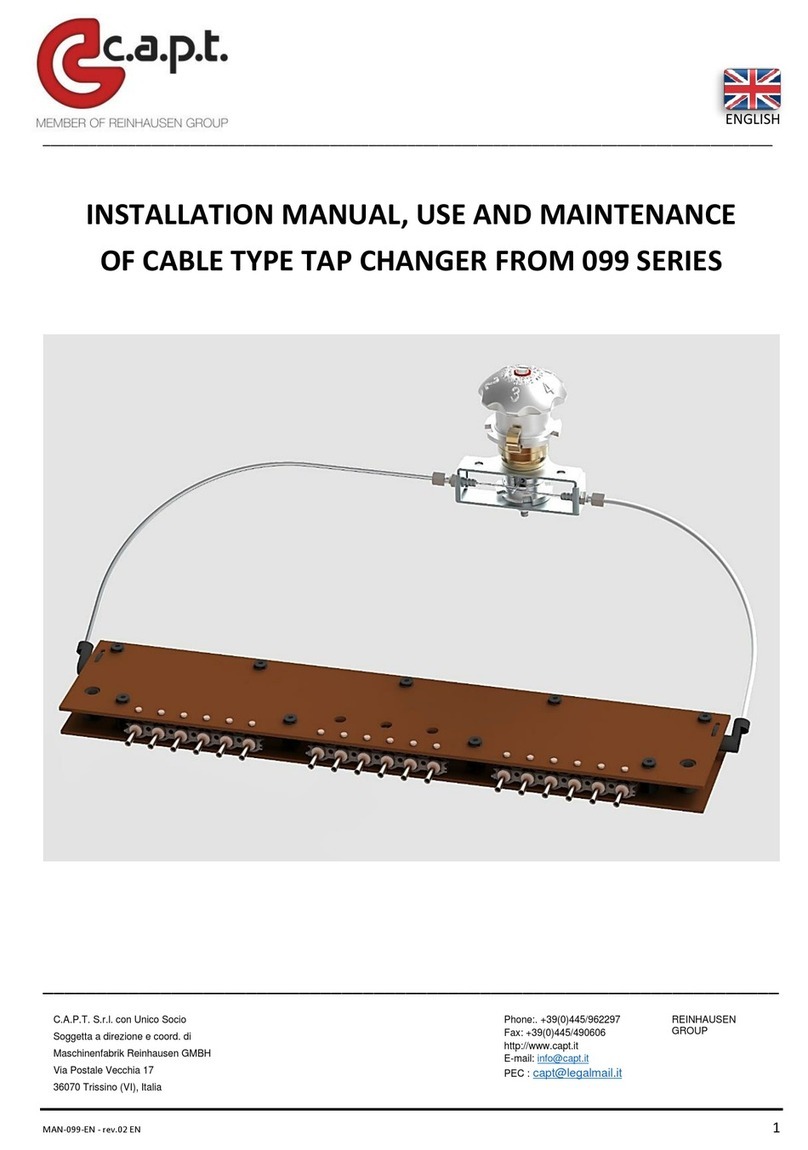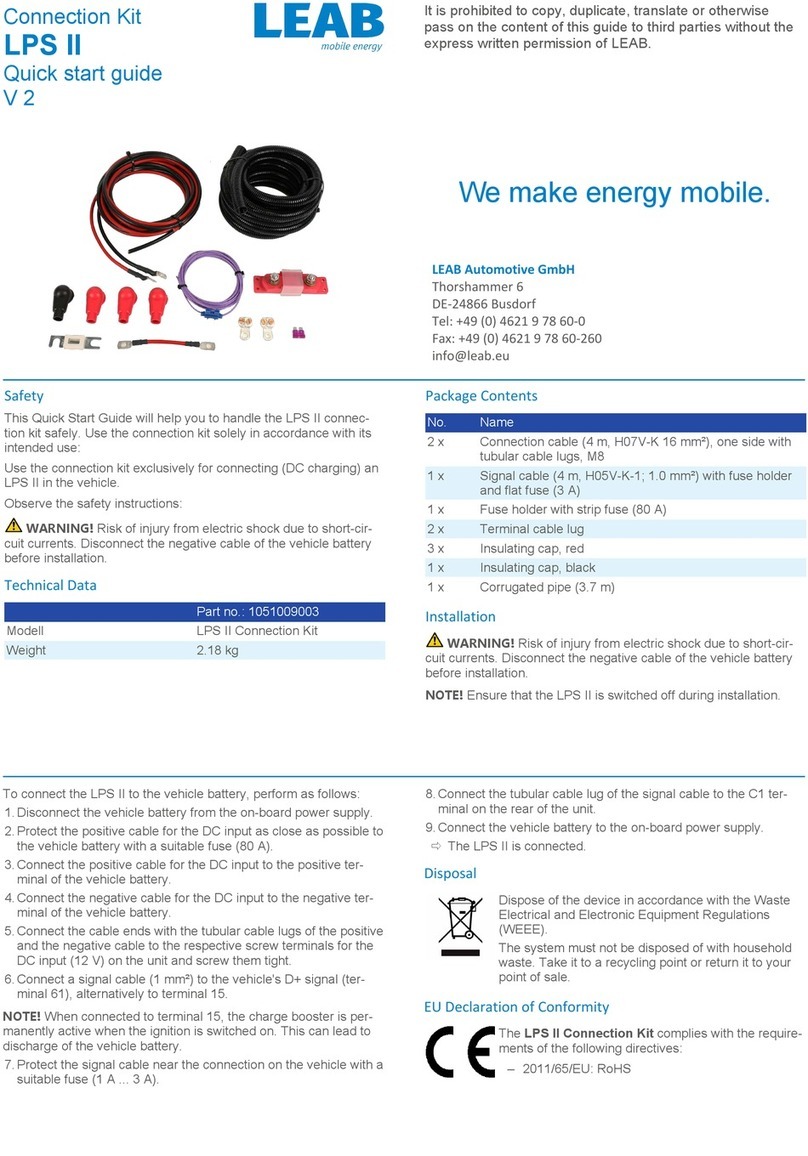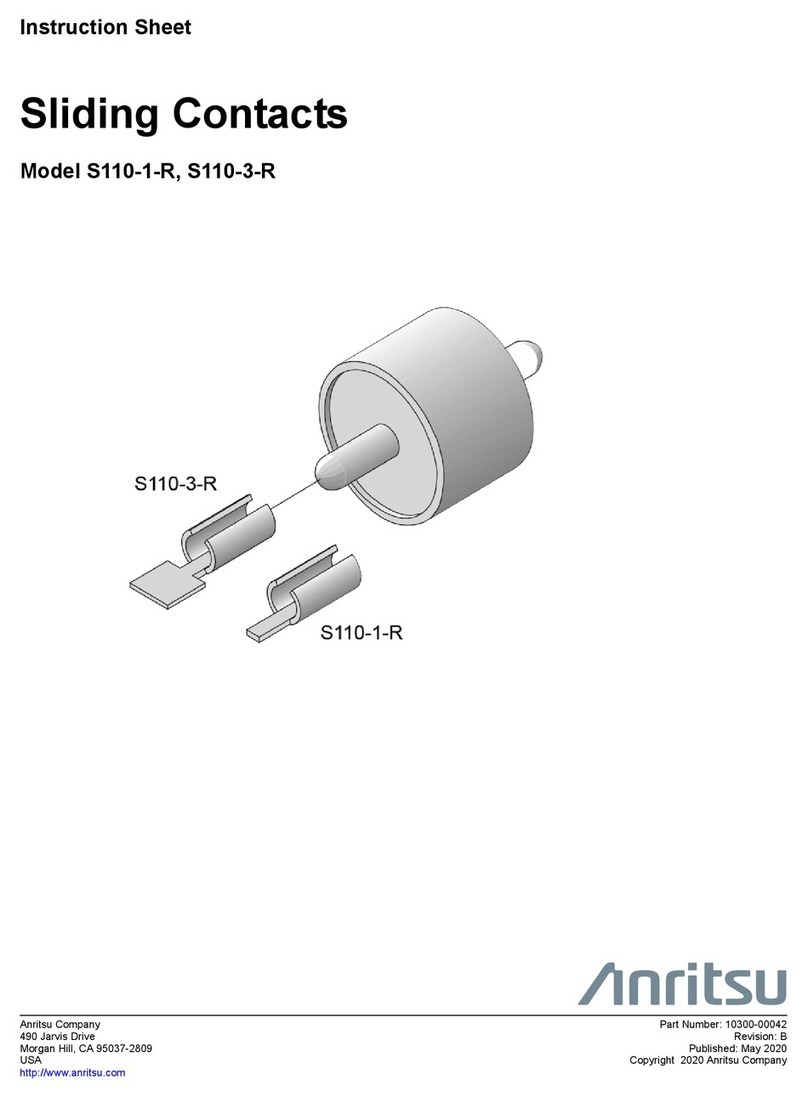MyTana M20 User manual

Manufacturers of Quality
Sewer & Drain Cleaning
Equipment since 1957
(800) 328-8170
Factory Direct Customer Service
M –F 7am – 5pm CST
Competent • Polite • Clear
www.MyTana.com
746 Selby Ave • St. Paul, MN 55104
fax: (651) 222-1739
User Guide for
M20 or M20T Jetters
M20T
M20
shown with
optional hose
and reel
042622
IMPORTANT
FOR YOUR SAFETY, AND
TO ENABLE MAXIMUM
EFFECTIVENESS OF YOUR
EQUIPMENT, READ
(AND UNDERSTAND) THIS
INSTRUCTION MANUAL
ENTIRELY BEFORE USING
YOUR HIGH-PRESSURE
WATER JETTING UNIT
FAILURE TO FOLLOW
INSTRUCTIONS AND
REGULATIONS CONTAINED IN
THIS MANUAL CAN RESULT
IN SERIOUS INJURY TO THE
OPERATOR AND/OR TO
ANYONE IN CLOSE PROXIMITY
TO THE WORK AREA.
The pump/motor unit may be removed
from the cart on the M20 model.
The cart holds our Large
Hose Reel as shown.
The M20T is the pump/motor unit only, no cart or reel.

PG 2 MyTana M20T / M20 JETTER User Manual
Safety First!
Instructions and Precautions
Environment
• Use caution in conned or wet areas. When working
directly through clean outs or openings into sewers
(non-trapped openings) make sure that there is
adequate ventilation into the work area.
• Do not operate machine in areas where
ammable gases or liquids are present.
Keep bystanders or unauthorized persons away
Insist they keep a safe distance before operating
high pressure equipment.
• Never hold on to nozzle or point it at anyone with
machine turned on. High pressure water streams can
cause serious bodily harm.
Never run your jetter without a properly grounded
electrical supply and hookup. This is electric equipment
in a wet environment. Every precaution should be taken
when water and electricity are in close proximity.
• If an extension cord is needed beyond the built-in 25’
cord, use 12gauge or heavier to power the M20
• Avoid getting the electrical connections and
components wet.
Shut the machine down:
• When changing nozzles, hose or reels.
• Before disconnecting water supply. Running a water
pump “dry” will seriously damage the water pump.
• If it will be unattended.
• If machine fails to run properly.
Maintenance Follow antifreeze and maintenance
procedures as outlined in this manual.
Common Sense Don’t operate equipment under the
inuence of drugs, alcohol or if taking medication that
alters alertness.
• NEVER run ammable liquids or toxic chemicals (such as
insecticide or weed killer), acids or hard caustics (such as
lye) through the pump. Only water!
• NEVER use chemicals or agents that are not compatible
with the PVC (polyvinyl chloride) or neoprene covering of
the hose.
• NEVER clean the machine using its own spray.
High-pressure spray could damage components.
Keep all labels, decals, warnings, cautions, and instructions
with machine. For new decals or labels contact Mytana.
The Jetting Process
Sewer jetting (or hydro-jetting) uses a combination of water
pressure (psi) and ow (gpm) through a hose and nozzle to
ush debris out of drains or sewer lines.
Water jetting is used to penetrate and wash out clogs or ice,
potential blockages or to simply clean the walls of drains
and sewer lines to prevent future blockages.
Sewer jetting diers from normal pressure washing:
• Sewer jet nozzles direct the ow of water back toward
the operator at a 20 to 45 degree angle. This backward
stream propels the sewer nozzle and hose forward into
the sewer line and also cleans the walls of the pipe.
• Jetting pumps deliver more ow and controlled
pressure to clear tough blockages.
Components of hydro jetters: Water pump, motor, hose
reel; various sub-components that protect the pump and
the operator; various nozzles for various cleaning applica-
tions and situations. Larger jetters use a water storage tank
for water supply buer.
MyTana stocks replacement parts for our
jetters. Many are available to purchase
online at mytana.com/jetter-parts

PG 3 MyTana M20T / M20 JETTER User Manual
Assembly
Remove“shipping”plug on top side of pump and
replace with vented plug. This is very important for
the proper operation of the pumps.
Do not store or run the pumps on its side or at
a sharp angle, since oil can run out of the vent plug.
Follow Pre-operation checklist and Operation instructions
as outlined on page 5.
Vented
Plug
Shipping plug
(be sure to
replace with
vented plug,
see above)
Model Details
Refer to the photos below for the location of controls and
components. Pump details are on next page.
M20T model will have the pump/motor caddy unit only.
Motor
Instructions for startup/shutdown of the motor are on the
following pages. Additionally, refer to the motor’s manual
for details and care of the motor.
M20 The motor/pump unit may be removed from the cart.
Pull out the lock-pin and lift the unit o the frame.
Hose and Nozzles
Your jetter works via the proper blend of water pressure
and water volume: the more water that has to pass through
the restriction of a hose, the less pressure you will have
at the nozzle end. To optimize cleaning power, use the
shortest hose with the largest inside diameter that you can.
The orices (holes) in the nozzle aect pressure. Over time,
the orices in your nozzle will wear, resulting in pressure
drop and reduced cleaning eectiveness. Nozzles need to
be replaced as normal wear occurs.
Source hose
connection
Vinyl Grip
Loading
wheel
10” pneumatic tires
On/O
switch
Lock-pin
secures
pump/
motor to
cart
Oil level
sight glass
Large Hose Reel
GFCI
Hose reel
swivel
Reel
rotation
lock-pin
1/4 turn
ball valve
M20 Reel back detail

PG 4 MyTana M20T / M20 JETTER User Manual
Pumps
Periodically change oil in pumps. See maintenance
schedule on back cover.
Do NOT run pump without water in it. This can damage
the cylinder walls, warp or crack the pump casing.
Do not use water more than 140° F. This will damage seals.
Your pump is equipped with a thermal relief valve. However,
to optimize pump protection you should still avoid water (or
any pumped uid) that is too hot on the inlet side.
NEVER run pump if there is ice in pump or outlet hose.
See instructions on page 6 for antifreeze procedure.
uIf the M20 will not be used for more than 2-3 days,
even in warm temperatures, we recommend running
antifreeze through pump and hose before storage. This
greatly reduces the chance of rust, minerals and other
contaminants damaging the pump.
See a detailed breakdown of pump
components on page 7.
Pressure Regulator/Unloader
The regulator/unloader both regulates the pressure
and relieves pressure on the pump while in bypass. The
regulator knob is located at the pump. It allows you to
adjust pressure during operation.
At the end of each job, reduce the pressure to zero to
prevent pump lock.
Greater pressure requires more power/amperage from the
power source. On 15 amp circuits, maximum pressure may
be 1,200 psi, while 20 amp circuits can support 1,500 psi.
Thermal Relief Valve
Water temperatures in excess of 140° can damage the
pump seals. The thermal relief valve provides protection
when the pump goes into“bypass”, meaning the pump is
running but no water is being pushed through the hose.
Pulse Valve
The stem and handle extending from one cylinder of the
water pump enables pulsation of the water stream through
the hose and nozzle.
Turning the pulse control handle clockwise (right), one
valve of the pump is temporarily disabled. This creates
pulsation or vibration in the hose, allowing the hose to
“wiggle”through multiple or tight bends easily. Turn the
control left to stop pulsation.
NOTE: Pulsing creates extreme vibration and faster wear
on the pump. Use pulsation only as needed, do not use if a
blockage or sewer line conguration does not require it.
Water Inlet and Filter
Before attaching source hose to the jetter, run water
through the source hose to ush debris out of the faucet
and hose. Make sure the water is running clean and clear.
The water inlet has a lter to prevent small debris from
running through your pump. However recheck the inlet
lter before each use to make sure there is no obstruction.
Pressure Regulator /
Unloader
Garden hose
hook-up
Water inlet lter
Pulse-abler
valve
Thermal relief
valve
Pressure gauge 1/4 turn switch

PG 5 MyTana M20T / M20 JETTER User Manual
Operation Instructions
1. Attach garden hose (minimum of 5/8”diameter) to
water faucet. Run water through the hose into an
open drain or bucket to ush debris out of faucet and
hose before connecting to pump. Shut water o again
when water runs clear.
2. Attach other end (male end) of garden hose to water
inlet valve at pump.
3. M20 Hose on reel is ready to go. If using smaller
trap hose, disconnect jumper hose at the pump, and
connect the 1/8” jetter hose to the coupling
M20T Connect jetter hose to pump at the coupling
4. Attach nozzle to end of hose. Finger tighten, do not
over tighten.
5. Mark the hose approximately 10 feet back from
nozzle with electrical tape. Use this tape as a marker
to shut o machine before retrieving all the line out
of the drain pipe.
6. Open water intake.
7. Open water faucet again to prime pump. An equal
amount of water should pass through the orices of
the nozzle.
8. Push jetter hose into drain up to the marker when
possible (minimally several feet).
Always insert hose and nozzle into pipe opening and
hold onto hose before turning the machine on.
9. Make sure power cord is plugged into a properly
grounded 110 volt receptacle.
10. Start Motor/Engine by ipping switch into the
“on” position.
11. Adjust pressure with pressure regulator knob, turning
right to increase pressure, left to decrease.
12. Start jetting, using pulsation only if needed to promote
forward motion of nozzle and hose.
Pre Operation Checklist
• Check for adequate
water supply. Use no
smaller than 5/8” garden
hose for supply to pump
• Make sure water inlet
lter is clean.
• Check ground fault
interrupter on electric
models. Test and reset.
• Check uid levels: Oil in
pumps, oil & gas in gas
powered unit.
• Select nozzle and make
sure orices are not
blocked or worn to
excess
• Check hose for wear
or kinks
• Check hose reel and all
connections
During Operation
• Tight bends and certain blockages are often more
easily negotiated by rotating or twisting jetter hose
at drain opening. Once you are through that area,
pull back and pass through several times to ensure
cleaning. After the blockage(s) has been opened,
pull hose back very slowly to provide maximum
cleaning to wall of pipe.
• When operating from the high end to low end (most
common) shut o the water ow ball valve on the reel
occasionally. This will allow debris to get ahead of the
nozzle and ush it down the pipe.
• Grease and Ice Blockages Warm water is eective
in cleaning grease and ice blockages. A cold-hot mix
from the tap is adequate. However, do not exceed
140° Fahrenheit. Hotter water can damage seals in
the pump.
Shutting Down
1. When completing pass through drain, watch for tape
marker on hose as you pull the hose out.
2. Reduce pressure gradually with pressure regulator
knob until pressure gauge is at zero.
3. Stop the jetter motor/engine
• Move switch to“o” position
• Unplug power cord from receptacle
4. Continue to run water through pump and hose for
30 to 60 seconds.
5. Close water faucet and disconnect garden hose
from spigot.
6. Close water inlet valve. Disconnect garden hose
from jetter.
7. Pull remaining jetter hose from drain line.
8. Remove nozzle if you choose.
9. Store jetter hose properly on reel or in a
coil to avoid damage to hose.
Winterize/add
anti-freeze if
needed

PG 6 MyTana M20T / M20 JETTER User Manual
Troubleshooting
Problem Probable Cause Solution
Low Water Pressure
Worn nozzle Replace nozzle
Oversized nozzle Attache correct nozzle
Pulling air at inlet line Disassemble, reseal and reassemble
Inlet strainer clogged Detach hose, clean strainer
Pressure regulator wide open Turn pressure regulator to the right to increase
pressure
No Water ow
Kinked or collapsed garden hose Remove kink or replace worn hose
Water supply not turned on Turn water supply on
Clogged nozzle Remove nozzle & clean orices
Intake or reel valve primed Make sure valves are open
Inconsistent and/or
erratic pressure
Sucking air on inlet side of pump Make sure connections are tight
Partial blockage in inlet hose or lter Remove blockage
Pump not properly primed Disconnect hose at outlet & run until pump is
properly primed
Electric motor trips
circuit breaker OR
electric motor overheats
Extension cord is too small Replace with heavy duty extension cord
Pressure regulator at full pressure Reduce pressure with pressure regulator
Other electrical devices already drawing current
on circuit
Either temporarily disconnect other electric
devices or nd new circuit
Inadequate electric fuse or breaker Recommended 20 amp breaker/fuse
Exceeding maximum recommended pressure Reduce pressure at regulator
Clogged nozzle Clean or replace nozzle
Electric motor won’t start
No power at outlet Tripped circuit breaker. Reset breaker
GFI on power cord is tripped Reset GFI
Motor overload button is tripped Reset overload button
Water leaking from under
pump manifold
Worn packing (seals)
Ice damage Install new packing (seals)
Oil leaking from
underside of crankcase Worn piston rod seals Replace seals
Water in crankcase
Oil will take on a cream
color or look cloudy if
mixed with water
Humid air condensing into water in crankcase Change oil – see oil recommendations
on back page.
Worn packing and/or piston rod sleeve.
O-ring on plunger retainer worn Replace packing. Replace O-rings
Oil leaking at rear portion
of the crankcase
Damaged crankcase; rear cover O-ring’drain-
plug or sight glass O-ring
Replace cover O-ring, drain plug O-ring or sight
glass O-ring
Frequent or premature
failure of the packing
(seals)
Scored, damaged or worn plunger Replace plungers
Excessive pressure to inlet manifold Reduce inlet pressure
Abrasive material in uid passing through pump Properly lter uid being pumped. Use clean
hoses & ttings
Excessive temperature of uid being pumped Do not exceed 140 degrees
Running pump dry NEVER run pump dry!

PG 7 MyTana M20T / M20 JETTER User Manual
Care and Maintenance
Never let pump run dry!! Pump cavitation can occur in
only a few seconds of running dry.
Avoid running anything abrasive through pump
Abrasive materials will damage pump components,
resulting in total malfunction or minimally, loss of pressure
capability.
Be careful with jetter hose against sharp edges
Sharp edges can scrape, slice and generally damage hose
quickly. While hose is easily replaced, it pays to take care
by buering sharp edges with tape, cardboard, etc., to
maximize its useful life. MyTana has a TigerTail that helps
protect your hose, available at MyTana.com.
Do not use pulse valve more than necessary This device
is what enables high-pressure cleaning through multiple
turns in sink and sewer lines. However, the pulse valve also
creates extreme vibration and faster wear on the pump.
So, use as needed, but do not use if a blockage or sewer line
conguration does not require it.
Antifreeze Procedure
If you know there will be a period of 2-3 days when the
jetter will be idle OR if the jetter is stored in potentially
freezing weather, make sure to run antifreeze into pump
and hose as part of your shut down procedure. This helps
with lubrication and prevents o-rings from drying out.
Insert a short length of garden hose into a gallon of
antifreeze, turn on pump and run until you see antifreeze
coming out of the nozzle end of the hose. At next use of
jetter, you can recover most of that antifreeze when you
hook up to your water source. Antifreeze can be used
multiple times. However if it gets too diluted (more than
50% water) or if there is any discoloration, discard that
antifreeze and replace with new.
We recommend using RV antifreeze.
See back page for maintenance schedule.
M20/M20T – Pump Breakdown
Unloader
(pressure
regulator)
inlet lter /
garden hose
connection
3/8" to 3/8”
elbow
1/4 turn switch 3/8” hose
coupling
Pulse-abler
valve
Pressure gauge
Vented plug
Thermal Relief
Valve
Valve cap

PG 8 MyTana M20T / M20 JETTER User Manual
(800) 328-8170 |MyTana.com |EMAIL mytana@mytana.com youtube.com/videoMyTana
M–F |7a to 5p CST MYTANA LLC 746 SELBY AVE • ST. PAUL, MN 55104
Maintenance Schedule
Follow this maintenance schedule to maximize the
life of your jetting equipment.
SHUT OFF AND UNPLUG MOTOR BEFORE ATTEMPTING
ANY REPAIRS OR MAINTENANCE.
Inspect and check for: Frequency
Leaks in discharge or inlet tting and hose Daily
Adequate water supply to the pump Daily
Jet nozzles are not clogged or worn Daily
Pump oil level Daily
PRESSURE HOSE for wear and damage. Daily
INLET FILTER for dirt and sediment. Daily
Service item: Frequency
Pump Crankcase Oil Change 1st month or 25 hours
for “break in”
Then every year
or 500 hours
If water gets into oil,
change immediately
oil will take on a cream
color or look cloudy if
mixed with water
Recommended oil:
• Primary – General Pump (GP) Brand
• Secondary – SAE 30W, non-detergent
Add antifreeze to hose and
pump (see procedure on
previous page)
Stored in potentially
freezing temps
If jetter will be unused
for 2-3 days
Recommended: RV antifreeze.
Keep machine clean and dry to maximize performance
and longevity.
Notes
This manual suits for next models
1
Table of contents
Other MyTana Cables And Connectors manuals
Popular Cables And Connectors manuals by other brands
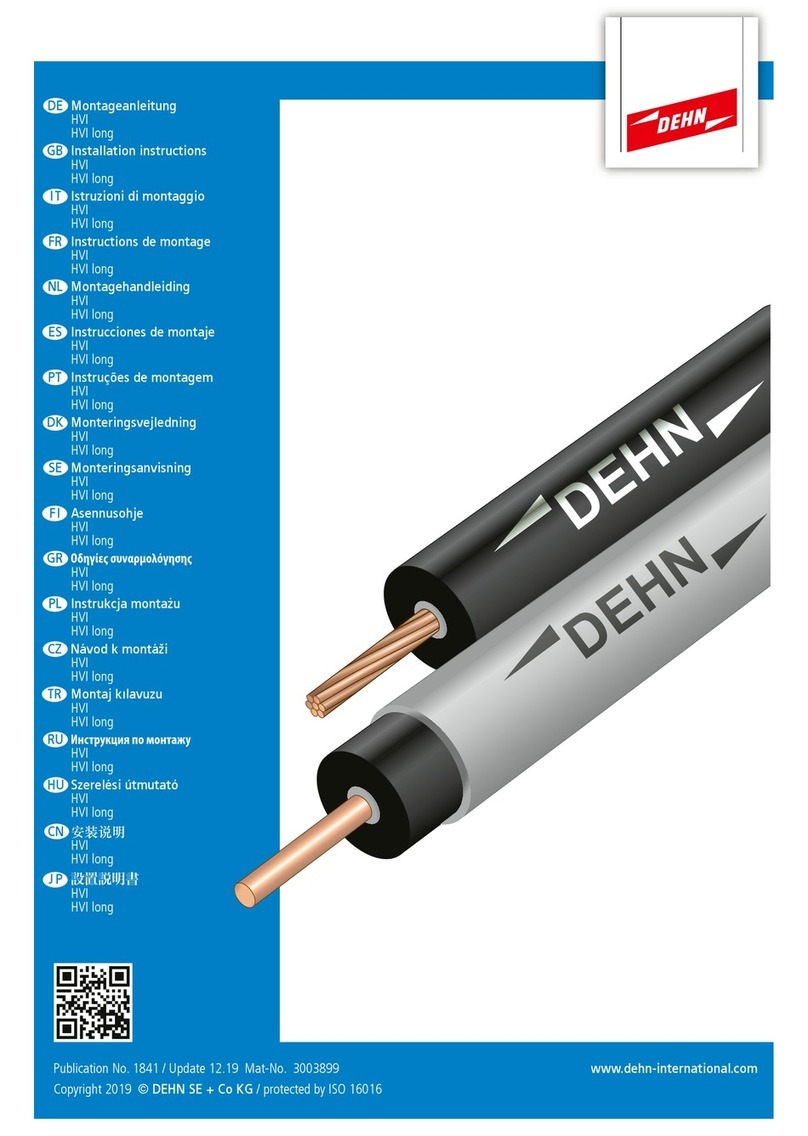
dehn
dehn HVI power installation instructions
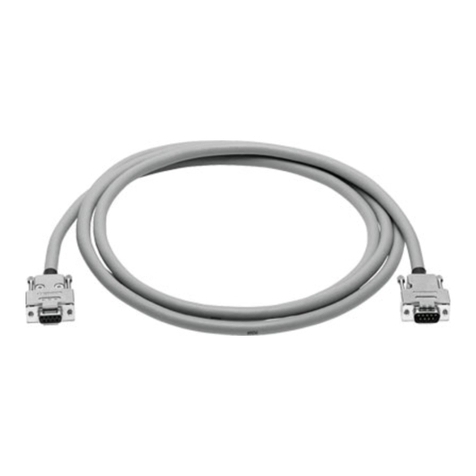
Festo
Festo NEBM-S1G9-E N-S1G9 Series Assembly instructions

Extron electronics
Extron electronics MHRVGA Specification sheet
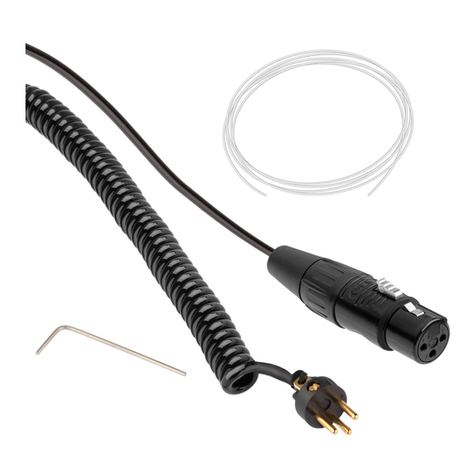
auray
auray ABC Series owner's manual
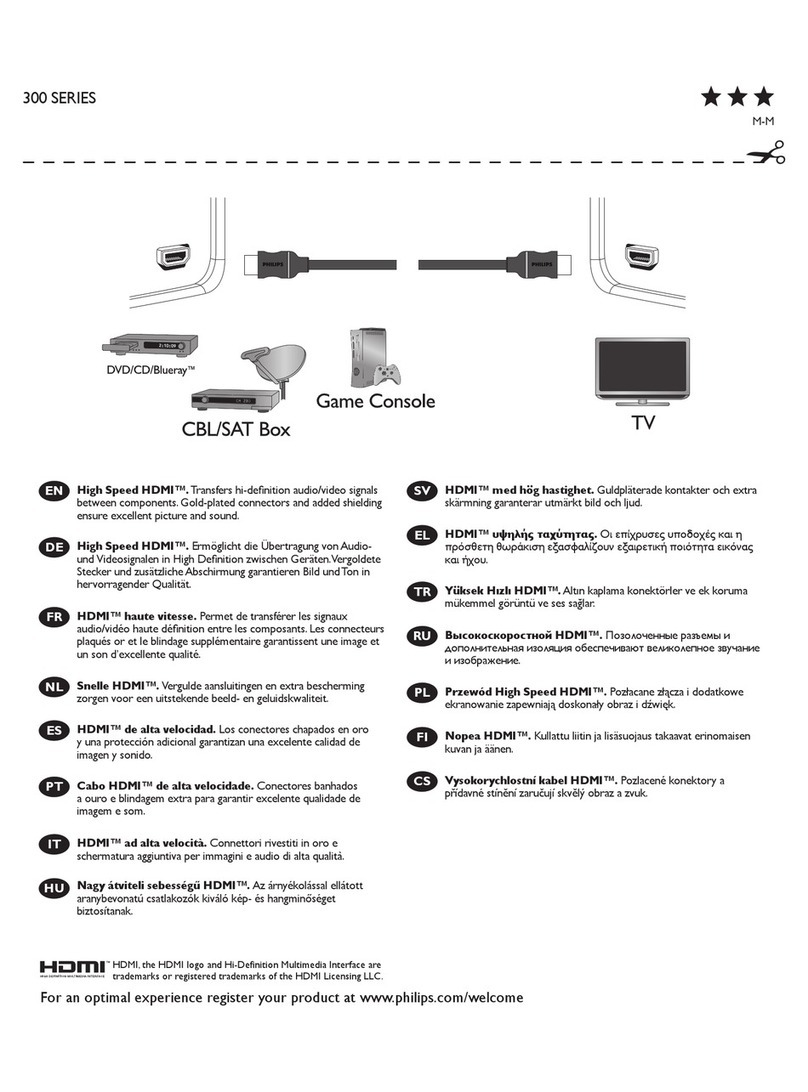
Philips
Philips Sonicare 300 SerieS user manual
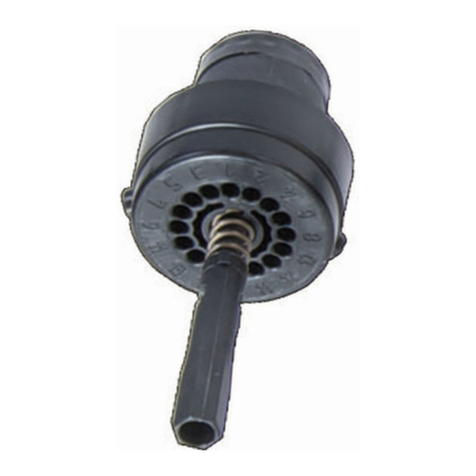
CommScope
CommScope FIST-RSKG-16 installation instructions

